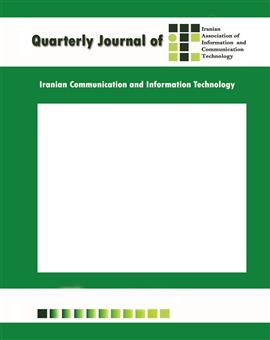بررسی تاثیر استفاده از انواع استراتژی¬های بازاریابی در شبکههای اجتماعی بر جلب اعتماد مشتریان شورایی
Subject Areas : Generalfarzaneh milani 1 , jafari zenouzi 2 *
1 -
2 -
Keywords: Marketing strategies, social networks, customer trust Marketing ترجمههای marketing اسمفراوانی بازار یابی marketing علم فروش marketing تعریفهای marketing اسم ۱ the action or business of promoting and selling products or services, including market research and advertising. the Western arts of marketing and distribution مترادف market فعل sellretailoffer for saleput up for salevendmerchandisetradepeddlehawkadvertisepromote همچنین ببینید market,
Abstract :
The aim of this study is to investigate the effect of using variety of marketing strategies in social networks to build customers’ trust. Marketing through social networks has made appropriate opportunities for companies to attract more customers. Building customers' trust and attracting the customers can be mentioned as marketing challenges on these networks. So, in order to create competitive advantages, companies need to use appropriate strategies of building trust. The population of this study consists of all Iranian users of social networking sites that affected by companies advertisements. Also the sample size by using snowball sampling method is 446. The research method is descriptive survey research and data collection tool is questionnaire. To test hypotheses the partial least squares (PLS) technique and SmartPLS 3 software has been used. The results show that all four variables include: transactional, relationship, database and knowledge-based marketing strategies in social networks have a significant impact to build customers’ trust. Indeed, transactional strategy has negative impact on trust so the relation between this variable and dependent variable is reverse. knowledge-based marketing strategy has the most positive impact on customers’ trust.
1. سیدجوادین، سید رضا، اسفیدانی، محمدرحیم و آقازاده، هاشم. (۱۳۸۶). بررسی استراتژی های بازاریابی در بازارهای الکترونیکی مورد مطالعه: شرکت های تولیدی برتر ایران. فصلنامه پژوهشنامه بازرگانی، ۴۲، 117-83.
2. Aghazadeh, H. & Esfidani, M.R. (2007). Internet Marketing Strategies”. Iranian Economic Review, 12(1), 179–191.
3. Blattberg, R.C., Kim, B., & Neslin, S.A. (2008). Database Marketing Analyzing and Managing Customers. Springer, New York.
4. Boyd, d. & Ellison, N. B. (2007). Social Network Sites: Definition, History, and Scholarship. Journal of Computer-Mediated Communication, 13(1), 210–230.
5. Brodie, R. J., Coviello, N. E., Brookes, R. W., & Little, V. (1997). Towards a Paradigm Shift in Marketing? An Examination of Current Marketing Practices. Journal of Marketing Management, 13(5), 383–406.
6. Brown, B.C., (2006). How to Use the Internet to Advertise, Promote, and Market Your Business or Web Site – With Little or No Money, Atlantic Publishing Group, Ocala, Florida.
7. Chailom, P. (2012). Antecedents and consequences of e-marketing strategy: evidence from e-commerce business in Thailand. International Journal of Business Strategy, 12, 75–87.
8. Fogel, J. & Nehmad, E. (2009). Internet social network communities: risk taking, trust, and privacy concerns. Computers in Human Behavior, 25(1), 153–160. Business Strategy, 12, 75–87.
8.Fogel, J. & Nehmad, E. (2009). Internet social network communities: risk taking, trust, and privacy concerns. Computers in Human Behavior, 25(1), 153–160. 1. Fornell, C., & Larcker, D. F. (1981). Evaluating structural equation models with unobservable variables and measurement error. Journal of marketing research, 18(1), 39-50.
2. Gladson-Nwokah, N., & Gladson-Nwokah, J. (2012). Strategic Use of Database Marketing for Marketing Decicion-Making. Research Journal of Information Technology, 4(2), 27–37.
3. Gregurec, I., Vranesevic, T., & Dobrinic, D. (2011). The importance of database marketing in social network advertising. In Proceedings of the International Journal of Management Cases, 27th-29th April, (pp.165-172). University of Dubrovnik, Croatia: Access Press UK, 13(4).
4. Harris, P. & McDonald, F. (2004). European business and marketing. Sage.
5. Larzelere, R. & Huston, T. (1980). The dyadic trust scale: Toward understanding interpersonal trust in close relationships. Journal of Marriage and the Family, 42, 595–604.
6. Mayer, R. C., Davis, J. H., & Schoorman, F. C. (1995). An integrative model of organizational trust. Academy of Management Review, 20(3), 709–734. McKnight, D. H. & Chervany, N. L. (2002). What trust means in E-commerce customer relationships. International Journal of Electronic Commerce, 6(2), 35–59 734.
15. McKnight, D. H. & Chervany, N. L. (2002). What trust means in E-commerce customer relationships. International Journal of Electronic Commerce, 6(2), 35–59.
16. Moretti, A., & Tuan, A. (2014). Social media marketing and relationship marketing: revolution or evolution? A first step analysis. sinergie, rivista di studi e ricerche, 93, 115-137.
17. Palmer, A. & Huo, Q. (2013). A study of trust over time within a social network mediated environment. Journal of Marketing Management, 29, 15–16.
18. Ramayah, T., & Rahbar, E. (2013). Greening the environment through recycling: an empirical study. Management of Environmental Quality: An International Journal, 24(6), 782–801.
19. Reichheld, FF. & Schefter, P. (2000). E-loyalty: your secret weapon on the web. Harvard Business Review, 78(4), 105–113.
20. Saxena, A. & Uday, Kh. (2013). Advertising on Social Nework Sites: A Structural Equation Modelling Approach. Vision, 17(1), 17–25.
21. Shaik, N. & Ritter, SH. (2011). Social Media Based Relationship Marketing. IGI Global, Chapter 9, 119–139
22. Šonkova, T. & Grabowska, M. (2015). Customer engagement: transactional vs. relationship marketing. Journal of International Studies, 8(1), 196–207.
23. Statista.2016 [Online]. Aviailable From: http://www.statista.com/statistics/278414/number-of-worldwide-social-network-users.
24. Tan, F., & Sutherland, P. (2004). Online Consumer Trust: A Multi-Dimensional Model. The Journal of Electronic Commerce in Organizations, 2(3), 40–58.
25. Teo, A. C., Tan, G. W. H., Ooi, K. B., Hew, T. S., & Yew, K. T. (2015). The effects of convenience and speed in m- payment. Industrial Management & Data Systems, 115(2), 311-331.
26. Zatari, T. (2014). Data mining in marketing. International Journal of Scientific & Engineering Research, 5(10), 1223–1226.
27. Zineldin, M. (2000). Beyond relationship marketing: technologicalship marketing. Marketing Intelligence & Planning, 18(1), 9–23.

